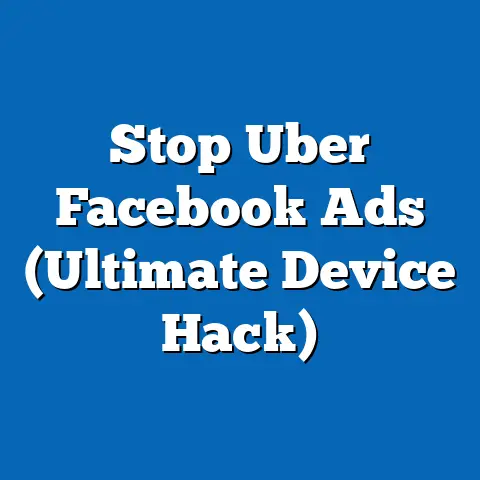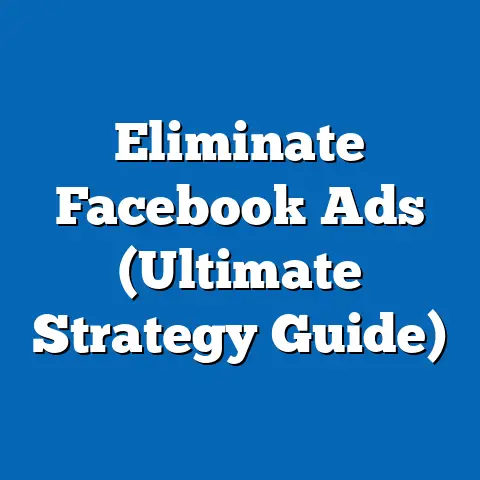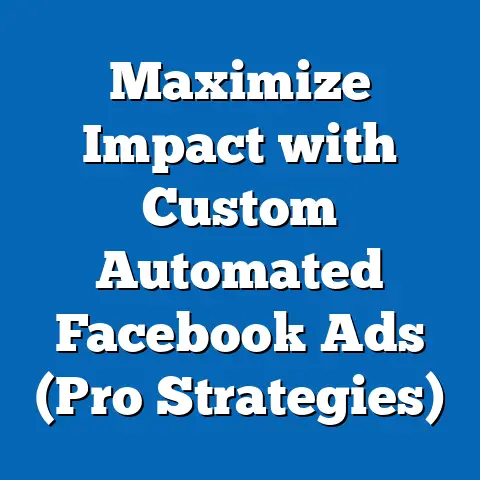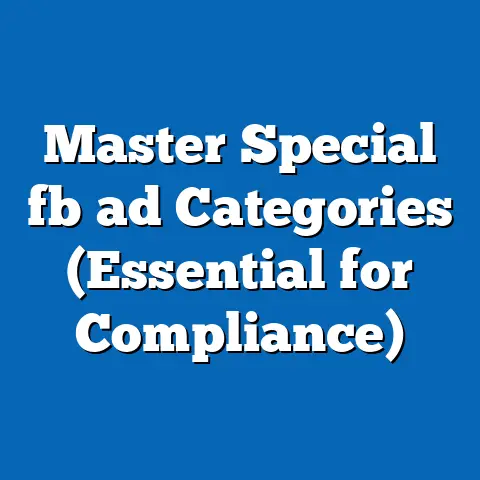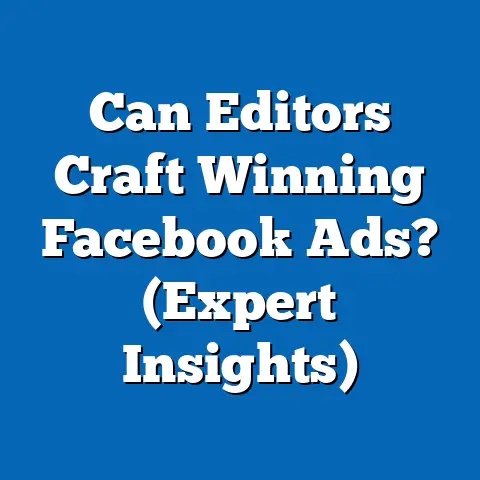Facebook Ads vs. Boosted Posts: What’s Best? (Insightful Guide)
In the vast landscape of digital marketing, where precision is paramount, marketers often find themselves at a crossroads: the sophisticated allure of Facebook Ads versus the seemingly simple charm of Boosted Posts. Both promise outreach and engagement, yet each embodies a unique philosophy on connecting with audiences. It’s like standing before two doors, each leading to different paths towards your marketing goals. One is a grand, ornate doorway promising tailored experiences, while the other is a simple, inviting entrance offering immediate visibility.
Facebook’s advertising ecosystem is a powerful tool for businesses of all sizes. With billions of users, the platform offers unparalleled reach and targeting capabilities. However, navigating this ecosystem can feel overwhelming. You’re bombarded with options, from intricate ad campaigns to the straightforward boost button. Understanding the nuances of Facebook Ads and Boosted Posts is crucial for any digital marketing strategy. They aren’t interchangeable; they’re distinct tools designed for different purposes.
1. Understanding Facebook Ads
Facebook Ads are the powerhouse of Meta’s advertising platform. They offer a level of control and customization that Boosted Posts simply can’t match. Think of them as the finely tuned instruments in an orchestra, each playing a specific note to create a harmonious marketing symphony.
1.1 What Are Facebook Ads?
Facebook Ads are paid advertisements created and managed within Facebook’s Ads Manager. Unlike organic posts, these ads are designed to reach a specific audience based on a wide range of targeting options. They’re not just about getting your message seen; they’re about getting it seen by the right people.
I’ve seen firsthand the power of well-crafted Facebook Ads. For a local bakery I worked with, we used carousel ads to showcase their delicious pastries and cakes. By targeting users within a specific radius who had shown interest in baking or desserts, we saw a significant increase in online orders and foot traffic to the store. This level of precision is what sets Facebook Ads apart.
Here are some common types of Facebook Ads:
- Image Ads: Simple yet effective, image ads use a single compelling image to capture attention.
- Video Ads: Perfect for storytelling and showcasing products in action.
- Carousel Ads: Allow you to display multiple images or videos in a swipeable format, ideal for showcasing a range of products or features.
- Collection Ads: Designed for mobile shoppers, collection ads feature a catalog of products that users can browse directly from the ad.
- Lead Ads: Streamline the lead generation process by allowing users to submit their information directly within the ad.
- Instant Experience Ads: Full-screen, mobile-optimized experiences that load instantly, providing an immersive way to showcase your brand.
Targeting Options:
One of the biggest advantages of Facebook Ads is the ability to target specific audiences. You can target users based on:
- Demographics: Age, gender, location, education, job title, and more.
- Interests: Hobbies, passions, and things they’re interested in, based on their activity on Facebook and Instagram.
- Behaviors: Purchase behaviors, device usage, travel habits, and other actions they’ve taken online.
- Custom Audiences: Upload your own customer lists (email addresses, phone numbers) to target existing customers or create lookalike audiences.
- Lookalike Audiences: Find new people who are similar to your best customers.
1.2 The Mechanics of Facebook Ads
Creating Facebook Ads involves using the Ads Manager, a powerful interface that provides granular control over every aspect of your campaign. It can seem daunting at first, but once you understand the structure, it becomes a valuable tool.
Campaign Structure:
Facebook Ads are organized into three levels:
- Campaign: The top level, where you define your overall marketing objective (e.g., awareness, consideration, conversion).
- Ad Set: The middle level, where you define your target audience, budget, schedule, and ad placement (where your ads will appear).
- Ad: The bottom level, where you create the actual ad creative (image, video, text).
Ad Objectives:
Choosing the right ad objective is crucial for campaign success. Facebook offers a range of objectives to align with your marketing goals:
- Awareness: Generate interest in your product or service.
- Consideration: Get people to think about your business and seek more information.
- Conversion: Encourage people to take a specific action, such as making a purchase or filling out a form.
Creating a Facebook Ad:
- Go to Ads Manager: Access Ads Manager from your Facebook profile or business page.
- Create a Campaign: Click the “Create” button and choose your campaign objective.
- Define Your Ad Set: Set your target audience, budget, schedule, and ad placement.
- Create Your Ad: Choose your ad format, upload your creative assets, and write your ad copy.
- Review and Publish: Review your ad settings and click “Publish” to launch your campaign.
1.3 Cost Structure and Budgeting
Understanding how Facebook Ads are priced is essential for managing your budget effectively. Facebook uses an auction-based system, where advertisers bid for ad placements.
Pricing Models:
- Cost Per Click (CPC): You pay each time someone clicks on your ad.
- Cost Per Mille (CPM): You pay for every 1,000 impressions (times your ad is shown).
Factors Affecting Costs:
- Targeting: Highly specific targeting can increase costs.
- Competition: If many advertisers are targeting the same audience, costs can go up.
- Ad Quality: High-quality ads with engaging content tend to perform better and can lower costs.
- Placement: Some ad placements (e.g., Facebook News Feed) are more expensive than others.
Budget Strategies:
- Daily Budget: Set a fixed amount you’re willing to spend each day.
- Lifetime Budget: Set a total amount you’re willing to spend over the entire duration of your campaign.
Budget Allocation:
I’ve learned that effective budget allocation is key to maximizing ROI. Start by testing different ad sets with smaller budgets to identify the most profitable audiences and placements. Once you find what works, scale up your budget accordingly.
1.4 Measuring Success with Facebook Ads
Tracking your campaign performance is crucial for optimizing your ads and achieving your marketing goals. Facebook provides a wealth of data to help you understand how your ads are performing.
Key Performance Indicators (KPIs):
- Click-Through Rate (CTR): The percentage of people who see your ad and click on it.
- Conversion Rate: The percentage of people who click on your ad and complete a desired action (e.g., purchase, sign-up).
- Cost Per Acquisition (CPA): The cost of acquiring one customer through your ad campaign.
- Return on Ad Spend (ROAS): The amount of revenue generated for every dollar spent on advertising.
Tracking Tools:
- Facebook Analytics: Provides detailed insights into your website traffic and user behavior.
- Third-Party Tools: Google Analytics, HubSpot, and other tools can provide additional data and insights.
Takeaway: Facebook Ads offer unparalleled control and targeting capabilities, making them ideal for businesses with specific marketing goals and a need for detailed performance tracking.
2. Understanding Boosted Posts
Boosted Posts are the quick and easy way to amplify your organic content on Facebook. They’re like a megaphone for your existing posts, helping you reach a wider audience with minimal effort.
2.1 What Are Boosted Posts?
Boosted Posts are simply organic posts from your Facebook page that you pay to show to a larger audience. Unlike Facebook Ads, Boosted Posts are created directly from your page and offer fewer targeting options.
I often recommend Boosted Posts to small businesses that are just starting with Facebook advertising. They’re a great way to dip your toes in the water without getting overwhelmed by the complexity of Ads Manager. For example, a local coffee shop could boost a post about their new seasonal latte to reach more people in their area.
Typical Use Cases:
- Increasing engagement (likes, shares, comments)
- Reaching a wider audience
- Promoting events or special offers
- Driving traffic to your website
2.2 The Simplicity of Boosted Posts
The biggest advantage of Boosted Posts is their simplicity. You can boost a post directly from your Facebook page in just a few clicks.
Boosting a Post:
- Find the Post: Locate the post you want to boost on your Facebook page.
- Click the “Boost Post” Button: This button is located below the post.
- Define Your Audience: Choose your target audience based on location, interests, or demographics.
- Set Your Budget and Duration: Choose how much you want to spend and how long you want to run the boost.
- Review and Boost: Review your settings and click “Boost” to launch your boosted post.
User-Friendly Process:
The process of boosting a post is incredibly user-friendly, even for those with no prior advertising experience. The interface is intuitive and straightforward, making it easy to reach a wider audience quickly.
2.3 Cost and Budgeting for Boosted Posts
Boosted Posts are generally more affordable than Facebook Ads, making them a good option for businesses with smaller budgets.
Cost Structure:
The cost of a Boosted Post depends on several factors, including:
- Target Audience: Reaching a larger or more specific audience can increase costs.
- Duration: Running the boost for a longer period will cost more.
- Placement: Where your boosted post is shown (e.g., Facebook News Feed, Instagram Feed) can affect costs.
Budgeting:
Boosted Posts can fit into a smaller budget because you have more control over how much you spend. You can set a daily budget or a total budget for the duration of the boost.
Limitations:
While Boosted Posts are affordable, they offer less granular targeting than Facebook Ads. This means you may not be able to reach as specific an audience, which can impact your ROI.
2.4 Assessing Performance of Boosted Posts
Tracking the performance of your Boosted Posts is important for understanding their impact and optimizing your strategy.
Metrics:
- Reach: The number of people who saw your boosted post.
- Engagement: The number of likes, shares, comments, and clicks your boosted post received.
- Website Clicks: The number of people who clicked on a link in your boosted post to visit your website.
Insights:
Facebook provides built-in analytics for Boosted Posts, allowing you to track these metrics and gain insights into your audience.
Takeaway: Boosted Posts are a simple and affordable way to amplify your organic content and reach a wider audience. They’re ideal for businesses with smaller budgets and a need for quick results.
3. Key Differences Between Facebook Ads and Boosted Posts
While both Facebook Ads and Boosted Posts can help you reach a larger audience, they differ significantly in terms of targeting capabilities, objectives, user experience, and ROI.
3.1 Targeting Capabilities
This is where Facebook Ads truly shine. They offer a level of targeting granularity that Boosted Posts simply can’t match.
Facebook Ads:
- Detailed Demographics: Target users based on age, gender, location, education, job title, and more.
- Specific Interests: Reach people who have shown interest in specific topics, hobbies, or brands.
- Behavioral Targeting: Target users based on their purchase behaviors, device usage, and other online activities.
- Custom Audiences: Upload your own customer lists to target existing customers or create lookalike audiences.
- Lookalike Audiences: Find new people who are similar to your best customers.
Boosted Posts:
- Limited Demographics: Target users based on location, age, and gender.
- Basic Interests: Reach people who have shown interest in broad categories.
My Experience:
I once worked with a clothing boutique that wanted to target women aged 25-45 who were interested in fashion, specifically sustainable and ethically made clothing. With Facebook Ads, we were able to target users who had liked pages related to sustainable fashion, followed ethical brands on Instagram, and even purchased eco-friendly products online. This level of precision allowed us to reach a highly qualified audience and drive significant sales. With Boosted Posts, we would have been limited to targeting women in a certain age range who were generally interested in fashion, which would have been much less effective.
3.2 Objectives and Goals
Facebook Ads and Boosted Posts are designed for different marketing objectives.
Facebook Ads:
- Specific Marketing Funnel: Designed to guide users through the marketing funnel, from awareness to consideration to conversion.
- Specific Objectives: Offer a range of objectives, such as website traffic, lead generation, app installs, and sales.
Boosted Posts:
- Engagement and Reach: Primarily focused on increasing engagement (likes, shares, comments) and reaching a wider audience.
- Limited Objectives: Offer fewer objectives than Facebook Ads.
Example:
If you’re launching a new product and want to drive sales, Facebook Ads are the way to go. You can create a conversion campaign targeting users who are likely to purchase your product. If you simply want to increase brand awareness and get more people to see your content, Boosted Posts can be a good option.
3.3 User Experience and Creation Time
The user experience and creation time differ significantly between Facebook Ads and Boosted Posts.
Facebook Ads:
- Complex Interface: Ads Manager can be overwhelming for beginners.
- Time-Consuming: Creating a Facebook Ad campaign can take time and effort.
- Technical Knowledge: Requires some technical knowledge of advertising and targeting.
Boosted Posts:
- Simple Interface: Easy to use, even for beginners.
- Quick and Easy: Boosting a post takes just a few clicks.
- No Technical Knowledge: Requires no prior advertising experience.
My Take:
While Facebook Ads require a steeper learning curve, the level of control and customization they offer is worth the investment. Once you become familiar with Ads Manager, you can create highly targeted and effective campaigns.
3.4 Return on Investment (ROI)
The potential ROI for Facebook Ads and Boosted Posts depends on your specific goals and how well you execute your campaigns.
Facebook Ads:
- Higher Potential ROI: Can yield higher returns due to precise targeting and optimization.
- Better Tracking: Allows for better tracking of performance and ROI.
Boosted Posts:
- Lower Potential ROI: May yield lower returns due to less granular targeting.
- Limited Tracking: Offers limited tracking of performance and ROI.
Scenarios:
- High ROI Scenario: If you’re running a targeted campaign to drive sales, Facebook Ads are likely to yield a higher ROI.
- Lower ROI Scenario: If you’re simply boosting a post to increase engagement, Boosted Posts may be sufficient.
Takeaway: Facebook Ads offer more precise targeting, specific objectives, and better tracking, leading to a higher potential ROI. Boosted Posts are simpler and quicker to create but offer less control and lower potential ROI.
4. When to Use Facebook Ads vs. Boosted Posts
Choosing between Facebook Ads and Boosted Posts depends on your specific marketing goals, audience, and resources.
4.1 Situational Analysis
Here’s a breakdown of scenarios where each option is most effective:
When to Use Facebook Ads:
- Targeted Campaigns: When you need to reach a specific audience based on detailed demographics, interests, or behaviors.
- Specific Marketing Objectives: When you have specific marketing objectives, such as website traffic, lead generation, or sales.
- Product Launches: When you’re launching a new product and want to drive sales.
- Retargeting: When you want to retarget users who have previously interacted with your website or Facebook page.
- A/B Testing: When you want to test different ad creatives or targeting options to optimize your campaigns.
When to Use Boosted Posts:
- Increasing Brand Awareness: When you want to reach a wider audience and increase brand awareness.
- Promoting Organic Content: When you want to amplify your organic content and get more people to see it.
- Driving Engagement: When you want to increase engagement (likes, shares, comments) on your posts.
- Promoting Events: When you want to promote an event and reach people in your local area.
- Limited Budget: When you have a limited budget and want to reach a wider audience quickly.
4.2 Case Studies
Let’s look at some real-world examples:
Case Study 1: E-commerce Store
An e-commerce store selling handmade jewelry used Facebook Ads to drive sales. They created a conversion campaign targeting women aged 25-45 who were interested in jewelry and had previously visited their website. They used carousel ads to showcase their products and offered a discount code to encourage purchases. The campaign resulted in a 300% increase in sales.
Case Study 2: Local Restaurant
A local restaurant used Boosted Posts to promote their weekly specials and reach more people in their area. They boosted a post with a photo of their featured dish and a call to action to visit their restaurant. The boosted post resulted in a significant increase in foot traffic and reservations.
4.3 Industry-Specific Considerations
Different industries may favor one option over the other based on their unique marketing goals and audience behaviors.
E-commerce: Facebook Ads are essential for driving sales and retargeting customers.
Local Businesses: Boosted Posts can be effective for reaching local customers and promoting events.
B2B: Facebook Ads can be used to generate leads and drive traffic to your website.
Nonprofits: Both Facebook Ads and Boosted Posts can be used to raise awareness and solicit donations.
Takeaway: Consider your specific marketing goals, audience, and resources when deciding whether to use Facebook Ads or Boosted Posts.
Conclusion
Both Facebook Ads and Boosted Posts have their place in a comprehensive social media marketing strategy. They are not mutually exclusive; they are complementary tools that can be used together to achieve your marketing goals.
Facebook Ads offer unparalleled control and targeting capabilities, making them ideal for businesses with specific marketing objectives and a need for detailed performance tracking. Boosted Posts are a simple and affordable way to amplify your organic content and reach a wider audience, making them a good option for businesses with smaller budgets and a need for quick results.
Before deciding which approach to take, assess your specific goals, audience, and resources. Consider what you want to achieve, who you want to reach, and how much you’re willing to spend.
The world of digital marketing is constantly evolving, and the strategies that work today may not work tomorrow. Stay informed, experiment with different approaches, and adapt your strategies to meet changing needs. By understanding the nuances of Facebook Ads and Boosted Posts, you can harness the power of Facebook’s advertising platform and achieve your marketing goals. So, go forth and create campaigns that resonate, engage, and drive results! Your audience awaits.

